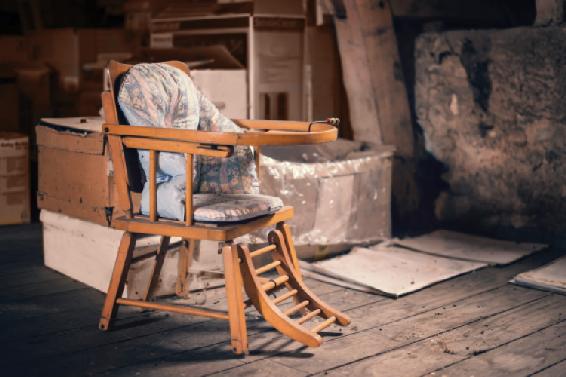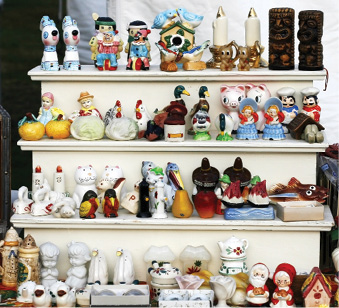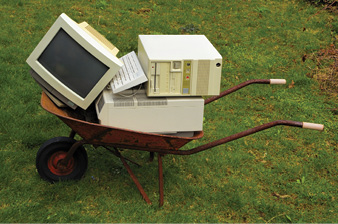The best way to get rid of clutter is to purge and purge often. That being said, letting go of our belongings can be really hard sometimes. For a lot of people (including myself), some of the most difficult things to part with we don’t even like (or want) in our homes in the first place. You may be thinking, why would anyone have a hard time letting go of stuff they don’t even like? However, the struggle is real, and I would bet it’s happening to you, too. As silly as it sounds, many of us hold onto things, not out of love, but out of guilt. I like to call these things “guilty clutter.”
Guilty clutter is unwanted items we are holding onto out of obligation. Maybe it’s that expensive treadmill you haven’t used in five years or your great grandmother’s china that was passed down to you. We all have unloved and unused things taking up valuable space in our homes.
Here’s the bottom line: nothing good can come from holding onto unwanted stuff. This fear that we are giving away hard-earned money, hurting someone’s feelings, or disrespecting our loved ones who have passed away is all in our heads. It’s time we overcome that fear and open ourselves up to the joy that comes from letting go.
Let’s talk about the different types of guilty clutter and the ways we can overcome the need to keep it. I promise you, letting go will feel so much better than holding on.
Sentimental Clutter
I wanted to jump right in with the hardest kind of clutter to let go of, the touchy-feely kind. For you, it may be your grandmother’s beloved china dishes or those boxes of thirty-five-year-old baby clothes in your attic. I’m not talking about the keepsakes you love and cherish and proudly display in your home; what I want to address is the stuff you feel you have to keep, even though you don’t want to. The sentimental clutter I’m talking about is usually forgotten and boxed up in your basement collecting dust, yet the thought of getting rid of it can still give you heart palpitations.

Shortly after my husband and I had our third child, our son Milo, my mother-in-law brought over two huge totes filled with my husband’s baby clothes she had kept all these years. My husband was born in the ‘80s and no clothing from this era should ever see the light of day again. I tried to contain my horror at the thought that she wanted my son to wear his father’s old clothes. I mean, I’m no fashion snob, but thirty-year-old faded and musty smelling baby clothes look better in a box than on a baby. Still, it was fun going through the boxes and seeing all of the memories inside. The only problem was, these boxes were now mine to keep, and I had no storage space whatsoever to keep them in. My sweet mother-in-law had just passed her guilty clutter onto me.
I tried to politely suggest I just pick out a few pieces of clothing from the box and she could keep the rest, but she dropped a truth bomb on me so big that all I could do was laugh. “I don’t want these in my house,” she said sheepishly. “I have wanted to get rid of them for years, but I felt so guilty, so now I can give them to you.”
Ummmm, thanks?
It’s what we do. We keep our baby clothes and other sentimental keepsakes because we feel we “should” or that it is a “good parent” thing to do, and then we end up passing the buck onto our kids when they get older. Sometimes, we pass down our guilty clutter from generation to generation. By the time the youngest generation gets the stuff, it’s so loaded with guilt, letting go of it would never be an option.
I’m not suggesting we never keep anything, or that it is wrong to hold onto mementoes, keepsakes, and baby items. I’m suggesting that keeping a few special pieces of clothing is a much better idea than keeping two boxes full. I am also suggesting that passing those few special pieces of clothing onto your children when they are grown should come with a disclaimer that, in no way, should they feel obligated to keep anything they don’t want to.
A few years ago, I had a wonderful client who lived in a modest two-bedroom home with her husband. They had been saving for years with the dream of remodeling their home, and now that they were both recently retired, that dream was about to become a reality. The problem was, her home was so full of stuff they had no place to put anything during the remodel—hence why she had contacted me.
I decided to begin in the spare bedroom, because it was the fullest room in the house, with barely a path to get inside. The room was filled with dozens of stacked boxes, and they honestly had no idea what was in most of them. My first suggestion was, because you don’t even know what is in the boxes, let’s have them go to charity without even opening or looking inside. The terror in her face was all the answer I needed, and we spent the next week going through each and every one of those boxes.
Almost everything in that room was guilty clutter. She had a huge collection of salt and pepper shakers, that at one point, were displayed in her kitchen on endless shelves. She confessed she no longer wanted to display them and that, more than anything, she wanted a clean and modern-looking kitchen and home. As she unwrapped and looked through her collection, she gushed over the memories that each shaker brought her. She wanted to keep them all, but she didn’t want them displayed.
This is the part of my job as a Professional Organizer I loathe. I know my clients need to let go of their unwanted things in order to have what they really want, but getting them to let go of the guilt is an emotionally draining process for everyone. After a while, my client began to understand that her salt and pepper shakers were not the physical memories she had attached to them; her memories she could hold onto forever. She realized that taking pictures of the shakers and keeping a photo album could allow her to keep those same memories, while letting go of the actual clutter. In the end, she kept only five sets out of over one hundred, and the rest were sold on eBay.
The best part of this particular organizing gig was the tears of relief my client shed when her spare bedroom was finally emptied. She now had a place for her daughter to sleep when she visited and a designated quilting space, something she had always dreamed of having. The money they received from eBay for the sale of her salt and pepper shakers was enough for her and her husband to get some expensive upgrades on their remodel. My favorite of the entire process was that her reluctance to let go of guilty clutter was completely gone, and she was able to tackle the rest of her home without the fear and guilt she had before.

I could tell you dozens of stories, each one just as inspiring as the last, but instead I want to give you some easy tips that can help you get rid of that unwanted sentimental clutter in your home.
- • You are not honoring your loved ones’ memories by storing their prized possessions in a box in your basement or attic. You could honor them best by passing those items on to someone who would love and cherish them as much as your loved ones did.
- • Physical items are not the memories themselves. Take photos of these special things and write down the memories you have attached to them. Create a photo album you can look at often, and let the physical stuff go to charity so that it can continue to make new memories elsewhere.
- • Transform the unused items into something useful. I love the idea of having a baby blanket made out of old baby clothes, or making an accent pillow from your father’s favorite t-shirt. Transforming those things from the past into something beautiful and that you love today is a wonderful way to honor the memory.
- • Remind yourself that you don’t want to burden your children with the keepsakes you are saving for them. I promise you, I am not sad my mother didn’t give me boxes full of the artwork I made as a child. She did keep one small box of mementoes for me, which I thought was sweet, but even those are now items I feel obligated to also hold onto. Be mindful not to pass on our guilty clutter to our loved ones.
- • Your collectibles are not worth as much as you think they are. If I had a dollar for every client that had a collection of Beanie Babies®, I could take a pretty sweet vacation somewhere exotic with the cash. People collect things, assume they are worth something, and hold onto the collection for years in the hopes of cashing in. In my experience, the collection is usually worth only a fraction of what it was hoped to be worth, and people are left resentful for having held onto it for so long. I would recommend checking out the prices on sites like eBay to get a good idea of what your collection is really worth, and see if it is worth the space it takes up in your home.
Just because your mother loved her Royal Doulton collection does not mean you have to keep it in your home after she is gone. Having unwanted clutter can cause you stress and resentment your loved ones would never want you to feel. Take pictures, rejoice in the memories, and then give or sell those items to someone who will give them the love they deserve. Your home is your sanctuary and should be filled only with things you yourself love and cherish today, not items that were only loved in the past.
Expensive Clutter
We have all made expensive purchases we later regretted, like my dust-collecting treadmill, but we also have expensive out-dated items that can be just as hard to part with. I can’t tell you the number of clients I had who were storing old electronics or workout equipment in their basement, just because they couldn’t bear to get rid of such high priced items.
Following into the same category as expensive clutter are all of those items people hold onto because “they may need them some day.” No one wants to get rid of something and then have to purchase it again later when they need it, so the fear of spending unnecessary money causes some people to hold onto things they will likely never need again.
Unfortunately, sometimes we tend to think of our belongings as having the same value as the day we bought them. You may have spent one thousand dollars on your television ten years ago, but today you would be lucky to get one hundred dollars for it. By storing it in your basement, you are not one thousand dollars richer; that money you spent on your TV is already long gone. Holding onto expensive items out of fear of losing money can quickly escalate and turn your home into a cluttered mess.

For some people, letting go of unused items can feel like throwing away hard-earned cash. This fear is intensified in people who are struggling financially or have struggled in the past. I have even seen clients who had learned this hoarding behavior from their parents, even though they had never lived in poverty themselves.
Here are a few tips to help you let go of expensive clutter and stop seeing your belongings as the dollar amount you spent on them.
- • Remember that the money you spent on your item is gone. You are not any richer because you store this item in your home, and you won’t be poorer if you let it go.
- • Selling your unused items through an online sale can really be a motivating way to purge. Just remember to price your things appropriately; any money you receive will be much more than you are making from it just collecting dust in your house.
- • Ask yourself, what is the worst thing that can happen if I get rid of this item? Most of the time, our fear of letting go is completely unfounded. When we stop and think about worst-case scenarios, we usually find that it’s really not that bad at all.
- • Donate your unused things to a charity you can feel good about. Sure, you spent a hundred dollars on that sweater you’ve never worn, but keeping it in your closet is just a reminder of your mistake. That money is gone, and keeping the sweater in your closet isn’t going to bring it back. Acknowledge your mistake and make it better by passing the sweater onto someone who will love it and wear it often. There are so many thrift stores that use your donations to help people right in your community.
- • If you haven’t used or needed something in twelve months, the odds are you never will. Holding onto things for someday only takes away from the things you need and use today.
- • Keeping unused things is taking from you, not giving. It doesn’t matter how much something cost when you bought it, if you aren’t using it then it’s taking up valuable space in your home for nothing. Not only is it taking away space, but those expensive items are making us feel bad and guilty every time we look at them; not to mention the stress that clutter can cause.
- • Purging or donating your unused items is not being wasteful. It is more wasteful to have something collecting dust in your house instead of recycling it or passing it on to someone who will really use it.
Purging is by far the most difficult part of getting organized, and you will need to push yourself in order to see real results in your home. Just remind yourself of your end goal; a clean and clutter-free home.
You don’t have to be a minimalist to get there, but you may need to work through some fears you have with regards to letting go. Do you see your belongings as memories? Do you worry that getting rid of your belongings is throwing away money? Are you afraid you may really need that item again one day? Letting go can be a tough process, but I can promise you, it does get easier. The more you purge, the less fear you will have and the easier it will become. Start small and enlist the help of a friend or family member you trust if you have to.
Keep reminding yourself your unused items are taking from you, not giving. Let go of the clutter that makes you feel guilt, shame, and sadness today.